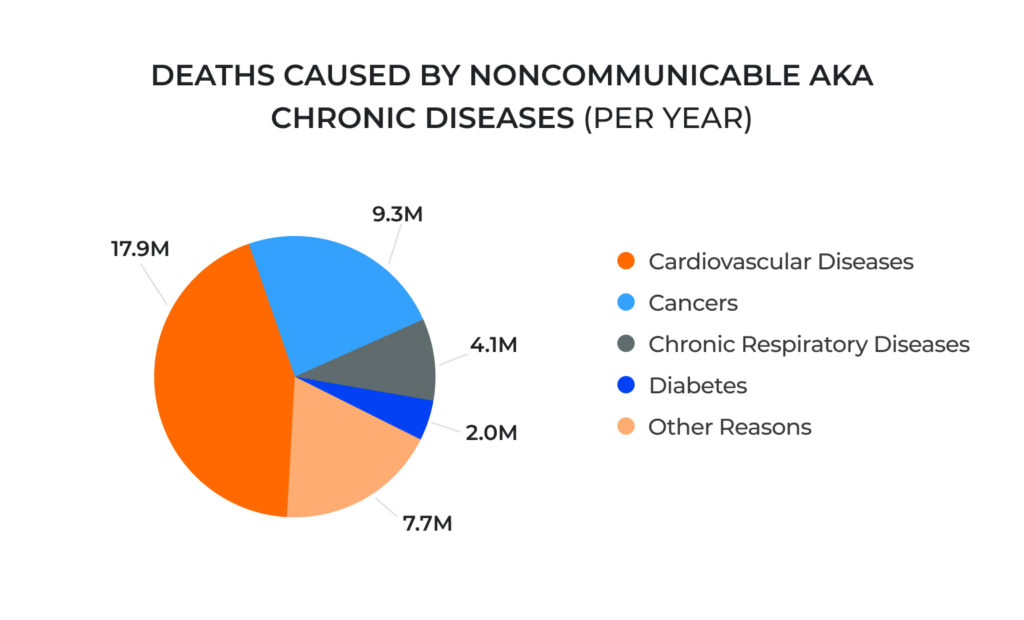According to the World Health Organization (WHO), the prevalence of non-communicable diseases (NCDs), also known as chronic diseases, has reached alarming levels, claiming the lives of a staggering 41 million individuals annually. These NCDs account for a shocking 74% of all global deaths, underscoring the urgent need for effective strategies to combat this growing crisis. Thankfully, applications of digital therapeutics help tackle these prevalent health conditions and improve patient outcomes.

In the face of this escalating global burden, exploring innovative solutions that can transform disease management and improve outcomes has become critical. Digital therapeutics (DTx) have emerged as a powerful tool, harnessing the potential of technology in healthcare. Digital therapeutics apps modify patient behavior and provide remote monitoring and support, paving the way for long-term health improvements.
By unlocking the potential of apps and digital therapeutics, we can usher in a new era of proactive and personalized healthcare, empowering individuals to take control of their well-being and offering healthcare providers invaluable tools to deliver effective and accessible treatments. Join us on this enlightening journey as we uncover the remarkable potential of digital therapeutics in transforming the landscape of disease management.
Power of Personalized & Proactive Interventions: Digital Therapeutics
The rise of digital therapeutics has witnessed a swift surge in popularity and acceptance within the healthcare industry, prompting regulatory agencies worldwide to adapt their frameworks to accommodate these innovative tools.
According to researchandmarkets.com, the global digital therapeutics market is rapidly growing, projected to reach $32.5 billion by 2030 with a lucrative CAGR of 26.1% from 2022 to 2030. This surge in market size can be attributed to various factors, such as the high demand driven by the COVID-19 pandemic, supportive regulatory initiatives, increasing smartphone penetration, and the growing prevalence of chronic disorders.

Amidst this growth, digital therapeutics have emerged as powerful tools that leverage personalized and proactive interventions to revolutionize healthcare. Let’s explore the advantages and the future of digital therapeutics in transforming the healthcare landscape.
- The Power of Personalized Interventions: By collecting and analyzing user data, these tools can adapt their recommendations and interventions to cater to the unique needs, preferences, and health conditions of each individual. This personalized approach allows for more targeted and effective treatments, ultimately increasing the likelihood of positive health outcomes.
- Proactive Role in Healthcare: Through real-time feedback, progress tracking, and ongoing support, these tools enable users to monitor their health and make data-driven decisions actively. By cultivating self-awareness and self-management, digital therapeutics empower individuals and instill a sense of control and responsibility for their own health. This active engagement in their healthcare journey will will result in enhanced outcomes and improved quality of life.
- Evidence-Based Interventions and Improved Outcomes: Digital therapeutics are built upon a foundation of evidence-based interventions. These interventions are developed and refined through rigorous clinical trials and research, ensuring their safety, efficacy, and adherence to medical best practices. By delivering evidence-based interventions, digital therapeutics provide healthcare providers and patients with reliable and trustworthy solutions for addressing medical conditions.
The study of the safety and efficacy of a prescription digital therapeutic as an adjunct to buprenorphine for treating opioid use disorder (OUD) highlights the potential of digital therapeutics in treating OUD. The study evaluates the safety and efficacy of a prescription digital therapeutic (PDT) in combination with traditional treatment methods.
Overview
This study aimed to see if digital therapy is safe and effective for people with OUD who are seeking treatment. The researchers examined data from a study that included 170 adults with OUD. Some participants got the usual treatment for 12 weeks, while others got the usual treatment along with digital therapy. The digital therapy had 67 interactive educational modules based on the Community Reinforcement Approach.
The usual treatment included buprenorphine therapy, meeting with a clinician every two weeks, and focusing on staying drug-free. The main things the researchers checked were whether people stayed in treatment and if they stopped using opioids during weeks 9 to 12. They also ensured the digital therapy was safe by looking at any bad reactions or side effects.
Result
The study showed digital therapeutics have great potential in treating opioid use disorder (OUD). People who used traditional treatment (TAU) and the digital therapeutic had a much higher chance of stopping opioid use during weeks 9-12 than those who only received traditional treatment—77.3% versus 62.1%. Also, the group using the digital therapeutic was less likely to leave treatment. Notably, the two groups had no significant difference in side effects.
This research reveals the positive impact of digital therapeutics on treating addiction. When the prescription digital therapeutic was combined with buprenorphine therapy, patients had better outcomes, with higher rates of stopping illicit opioids and staying in treatment. These results show that digital therapeutics can be a valuable and effective tool in dealing with opioid use disorder and other substance use disorders.
As the market continues to expand and regulatory frameworks evolve, digital therapeutics are positioned to have a significant impact on enhancing patient care and shaping the future of healthcare delivery. However, it is essential to acknowledge that there are also challenges associated with digital therapeutics that need to be considered when working on innovative digital therapeutics solutions.
OVERCOMING DTx CHALLENGES: UNLEASHING THE POTENTIAL OF APPLICATIONS AND DIGITAL THERAPEUTICS
Security and Privacy of Patient Data
A primary concern of digital therapeutics is ensuring the security and privacy of patient data. Given that these solutions handle confidential health information, it is vital to implement strong measures that safeguard patient privacy and adhere to applicable regulations, including the Health Insurance Portability and Accountability Act (HIPAA) and the requirements set forth by the Office of the National Coordinator for Health Information Technology (ONC) in the United States.
Solution
To address the security and privacy concerns associated with patient data, developers and healthcare organizations should use HIPAA and ONC-compliant solutions for healthcare data management. These solutions adhere to strict data protection protocols, encryption standards, and access controls to safeguard patient information and avoid severe penalties for neglecting sensitive healthcare data security.
Digital Therapeutics Integration
Integrating digital therapeutics into existing healthcare systems poses a challenge due to the diverse and fragmented nature of healthcare data systems. Seamless integration is essential for effective communication and data exchange between digital therapeutics platforms and electronic health records (EHRs) or other healthcare systems providers use.
Solution
By adopting the FHIR standard, digital therapeutics can seamlessly integrate with existing government health systems and EHRs. FHIR enables seamless data exchange, allowing healthcare providers to access relevant patient information and seamlessly incorporate digital therapeutics into their workflows. This integration facilitates a cohesive approach to patient care and enhances the overall effectiveness of digital therapeutics.
Promoting User Engagement
User engagement and adherence are critical factors for the success of digital therapeutics. Encouraging users to actively participate in their treatment plans and adhere to recommended interventions can significantly impact the effectiveness of these solutions. Motivating and sustaining user engagement over time presents a unique challenge.
Solution
Promoting user engagement requires a multifaceted approach. User-centric design, intuitive interfaces, and personalized experiences can enhance user engagement and motivation. Gamification techniques, such as rewards, challenges, and progress tracking, can also be incorporated to make the experience interactive and enjoyable. Regular feedback, reminders, and notifications can help users stay on track with their treatment plans. Integrating social support features and educational resources can also encourage user engagement and adherence.
CONCLUSION
The advancement of digital therapeutics can change how we approach healthcare monitoring and interventions. With personalized, proactive, and evidence-based interventions, healthcare apps empower individuals, enhance healthcare outcomes, and revolutionize how we approach health.
Still find the digital therapeutics field to be too complex to deal with? Then do not hesitate to contact us and schedule a demo of our FHIR-first healthcare data management tools. Our business analysts and certified FHIR experts are ready to help you ensure regulatory compliance, leverage the FHIR standards, and employ the most effective strategies to overcome challenges associated with DTx and unleash the full potential of apps and digital therapeutics.






